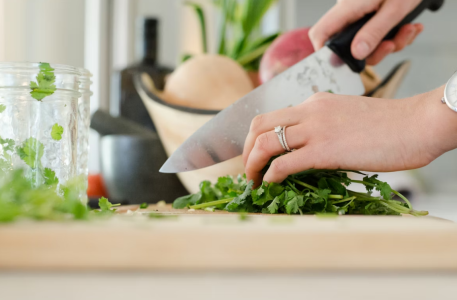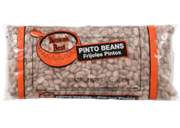20 Kitchen tricks chefs say will change the way you cook
- Replies 0
Sometimes the best lessons come from the smallest adjustments, the quiet tricks that only reveal their worth once you see them in action.
In the kitchen, professional chefs don’t rely on complicated secrets that feel out of reach for home cooks.
Instead, they adopt simple, repeatable habits that make meals taste better, prep feel easier, and mistakes less costly.
These are the kinds of tips that transform cooking from stressful to enjoyable, and they’re worth learning one by one.
1. Cookies Love Bread
When cookies or brownies turn dry overnight, a slice of fresh bread in the container revives them by morning. The bread transfers its moisture to the baked goods while drying out itself. It’s a tiny effort that makes desserts taste freshly baked again. Bakers rely on this trick because it works every time without fail.
2. Turn Down The Heat
High heat has its place for a quick sear, but steady, lower temperatures often produce better flavor. Eggs stay soft and creamy, vegetables develop a golden color instead of burning, and sauces thicken smoothly. Chefs know patience allows food to shine without the risk of scorching. Cooking slower often means cooking smarter.
3. The Secret To Easy Egg Peeling
Boiled eggs can be frustrating, but cracking them before an ice bath makes shells release in large pieces. The cold water seeps beneath the membrane, loosening it gently from the white. Smooth eggs are left behind, perfect for platters, salads, or snacks. It’s a small change that spares wasted time and torn results.
4. Toast Rice For Extra Flavor
Rice becomes fragrant and flavorful with just a few seconds of toasting in oil before adding liquid. This step releases a nutty aroma and helps grains remain separate instead of clumping. Swapping broth for water deepens the flavor further, making rice taste like a dish on its own. Cultures worldwide rely on this method for good reason.
5. Revive A Broken Sauce
When butter or cream sauces split, chefs don’t start over—they fix them. Dropping in an ice cube and whisking can quickly bring fat and liquid back together. The sudden chill rebinds the sauce and restores its smoothness. It’s a lifesaver for dishes moments from being ruined.
6. Sharp Knives Save Fingers
Contrary to instinct, dull knives are more dangerous than sharp ones. A blunt blade requires more force, which increases slipping and accidents. Sharp knives cut cleanly, making prep quicker and safer. Even casual honing at home drastically changes the cooking experience.
7. Respect The Microwave
Microwaves often get unfair criticism, but most problems come from misuse. Heating food at 50% power for longer creates even warmth without drying edges or leaving cold centers. Moisture and texture stay intact with this slower method. Professionals see the microwave as a tool worth mastering, not avoiding.
8. Potatoes To The Rescue
Soups and gravies that feel watery can be thickened smoothly with instant potato flakes. They dissolve easily, blend with flavor, and avoid the lumps flour sometimes causes. This trick works especially well in chowders or hearty vegetable dishes. It’s practical, inexpensive, and almost foolproof.
9. Broth Makes Everything Better
Homemade broth provides depth no boxed version can match. Using bones and vegetable scraps turns leftovers into liquid gold for soups, sauces, and risotto. Many chefs freeze small portions so broth is always ready to go. It’s a quiet habit that lifts everyday meals into something richer.
10. A Wooden Spoon Stops Boil-Overs
Pasta water seems to boil over at the worst times, but a wooden spoon balances across the pot can slow the foam. It’s not a guaranteed fix, but it buys valuable seconds before spills happen. The trick is simple and reduces mess with little effort. Small details often make the biggest difference.
Also read: 11 foods we used to love—where did they all go?
11. Burgers Deserve Soy Sauce
Right before melting cheese, chefs splash soy sauce into the pan with burgers. It quickly reduces into a savory glaze that clings to the patty. The result is deeper umami, more saltiness, and a flavor that lingers. Restaurant burgers often taste better because of tricks just like this.
12. Ginger Grates Better Frozen
Frozen ginger shreds cleanly into dishes without peeling or struggling with fibers. The freezer softens its texture, turning it into fine pieces that melt into sauces or teas. It also lasts months this way, reducing waste. Professionals love it for efficiency, and home cooks can adopt it easily.
13. Thermometers Aren’t Just For Steak
Chefs don’t rely only on intuition—they trust thermometers for consistency. Potatoes are perfectly done when their centers hit 210°F, while bread loaves can be tested the same way. Meat should come off the heat slightly early since temperatures keep rising while resting. This prevents underdone centers or dry results.
14. Scrap Bowls Are Underrated
A scrap bowl next to the cutting board streamlines prep. Peels, stems, and trimmings drop directly in, keeping the counter clear. Cleanup is faster, and trips to the trash can are reduced. Professional kitchens swear by this simple efficiency.
15. Pasta Water Works Magic
That cloudy water is liquid gold. Starch binds sauces and creates a silky coating that clings to noodles. Just a ladle added to marinara or Alfredo transforms the dish. Italian kitchens never waste it, and neither should you.
Also read: Creative ways to turn holiday leftovers into new meals
16. Get Onions Golden Faster
Caramelizing onions takes patience, but a pinch of baking soda speeds the process. The alkaline environment helps sugars break down quicker, producing golden onions in less time. Used carefully, it prevents soggy results. This saves time without sacrificing depth of flavor.
17. Acid Is A Seasoning Too
Salt and pepper often dominate, but acid finishes a dish with brightness. Lemon, vinegar, or pickle brine can lift heavy flavors instantly. A splash at the right moment cuts richness and sharpens taste. It’s the spark that completes the balance.
18. Toast Spices For Impact
Heat releases oils in spices, intensifying aroma and flavor. A brief toast or bloom in oil before adding other ingredients unlocks their full power. Curries, stews, or chilies all benefit from this step. It’s a one-minute investment with dramatic results.
19. Butter Needs A Partner
Butter adds flavor but burns quickly alone. Mixing it with oil raises the smoke point, allowing higher heat without scorching. This combination is perfect for sautéing, searing, or toasting. Chefs rely on it constantly for stability and richness.
20. Eggs And Cooling Racks Go Together
Cutting eggs evenly can be tedious, but pressing them through a cooling rack creates uniform pieces in seconds. Avocados work the same way, producing neat cubes for guacamole or salads. The trick repurposes a common tool for speed and consistency. Batch prep becomes easier with this small shortcut.
Read next: Transform your breakfast game with this cooking trick that would make your food 10x better!

Which of these chef-approved tricks do you think will change the way you cook at home, and have you already been using some of them without realizing their professional roots? Share your thoughts in the comments and let others know which hack made the biggest difference in your kitchen.
In the kitchen, professional chefs don’t rely on complicated secrets that feel out of reach for home cooks.
Instead, they adopt simple, repeatable habits that make meals taste better, prep feel easier, and mistakes less costly.
These are the kinds of tips that transform cooking from stressful to enjoyable, and they’re worth learning one by one.
1. Cookies Love Bread
When cookies or brownies turn dry overnight, a slice of fresh bread in the container revives them by morning. The bread transfers its moisture to the baked goods while drying out itself. It’s a tiny effort that makes desserts taste freshly baked again. Bakers rely on this trick because it works every time without fail.
2. Turn Down The Heat
High heat has its place for a quick sear, but steady, lower temperatures often produce better flavor. Eggs stay soft and creamy, vegetables develop a golden color instead of burning, and sauces thicken smoothly. Chefs know patience allows food to shine without the risk of scorching. Cooking slower often means cooking smarter.
3. The Secret To Easy Egg Peeling
Boiled eggs can be frustrating, but cracking them before an ice bath makes shells release in large pieces. The cold water seeps beneath the membrane, loosening it gently from the white. Smooth eggs are left behind, perfect for platters, salads, or snacks. It’s a small change that spares wasted time and torn results.
4. Toast Rice For Extra Flavor
Rice becomes fragrant and flavorful with just a few seconds of toasting in oil before adding liquid. This step releases a nutty aroma and helps grains remain separate instead of clumping. Swapping broth for water deepens the flavor further, making rice taste like a dish on its own. Cultures worldwide rely on this method for good reason.
5. Revive A Broken Sauce
When butter or cream sauces split, chefs don’t start over—they fix them. Dropping in an ice cube and whisking can quickly bring fat and liquid back together. The sudden chill rebinds the sauce and restores its smoothness. It’s a lifesaver for dishes moments from being ruined.
6. Sharp Knives Save Fingers
Contrary to instinct, dull knives are more dangerous than sharp ones. A blunt blade requires more force, which increases slipping and accidents. Sharp knives cut cleanly, making prep quicker and safer. Even casual honing at home drastically changes the cooking experience.
7. Respect The Microwave
Microwaves often get unfair criticism, but most problems come from misuse. Heating food at 50% power for longer creates even warmth without drying edges or leaving cold centers. Moisture and texture stay intact with this slower method. Professionals see the microwave as a tool worth mastering, not avoiding.
8. Potatoes To The Rescue
Soups and gravies that feel watery can be thickened smoothly with instant potato flakes. They dissolve easily, blend with flavor, and avoid the lumps flour sometimes causes. This trick works especially well in chowders or hearty vegetable dishes. It’s practical, inexpensive, and almost foolproof.
9. Broth Makes Everything Better
Homemade broth provides depth no boxed version can match. Using bones and vegetable scraps turns leftovers into liquid gold for soups, sauces, and risotto. Many chefs freeze small portions so broth is always ready to go. It’s a quiet habit that lifts everyday meals into something richer.
10. A Wooden Spoon Stops Boil-Overs
Pasta water seems to boil over at the worst times, but a wooden spoon balances across the pot can slow the foam. It’s not a guaranteed fix, but it buys valuable seconds before spills happen. The trick is simple and reduces mess with little effort. Small details often make the biggest difference.
Also read: 11 foods we used to love—where did they all go?
11. Burgers Deserve Soy Sauce
Right before melting cheese, chefs splash soy sauce into the pan with burgers. It quickly reduces into a savory glaze that clings to the patty. The result is deeper umami, more saltiness, and a flavor that lingers. Restaurant burgers often taste better because of tricks just like this.
12. Ginger Grates Better Frozen
Frozen ginger shreds cleanly into dishes without peeling or struggling with fibers. The freezer softens its texture, turning it into fine pieces that melt into sauces or teas. It also lasts months this way, reducing waste. Professionals love it for efficiency, and home cooks can adopt it easily.
13. Thermometers Aren’t Just For Steak
Chefs don’t rely only on intuition—they trust thermometers for consistency. Potatoes are perfectly done when their centers hit 210°F, while bread loaves can be tested the same way. Meat should come off the heat slightly early since temperatures keep rising while resting. This prevents underdone centers or dry results.
14. Scrap Bowls Are Underrated
A scrap bowl next to the cutting board streamlines prep. Peels, stems, and trimmings drop directly in, keeping the counter clear. Cleanup is faster, and trips to the trash can are reduced. Professional kitchens swear by this simple efficiency.
15. Pasta Water Works Magic
That cloudy water is liquid gold. Starch binds sauces and creates a silky coating that clings to noodles. Just a ladle added to marinara or Alfredo transforms the dish. Italian kitchens never waste it, and neither should you.
Also read: Creative ways to turn holiday leftovers into new meals
16. Get Onions Golden Faster
Caramelizing onions takes patience, but a pinch of baking soda speeds the process. The alkaline environment helps sugars break down quicker, producing golden onions in less time. Used carefully, it prevents soggy results. This saves time without sacrificing depth of flavor.
17. Acid Is A Seasoning Too
Salt and pepper often dominate, but acid finishes a dish with brightness. Lemon, vinegar, or pickle brine can lift heavy flavors instantly. A splash at the right moment cuts richness and sharpens taste. It’s the spark that completes the balance.
18. Toast Spices For Impact
Heat releases oils in spices, intensifying aroma and flavor. A brief toast or bloom in oil before adding other ingredients unlocks their full power. Curries, stews, or chilies all benefit from this step. It’s a one-minute investment with dramatic results.
19. Butter Needs A Partner
Butter adds flavor but burns quickly alone. Mixing it with oil raises the smoke point, allowing higher heat without scorching. This combination is perfect for sautéing, searing, or toasting. Chefs rely on it constantly for stability and richness.
20. Eggs And Cooling Racks Go Together
Cutting eggs evenly can be tedious, but pressing them through a cooling rack creates uniform pieces in seconds. Avocados work the same way, producing neat cubes for guacamole or salads. The trick repurposes a common tool for speed and consistency. Batch prep becomes easier with this small shortcut.
Read next: Transform your breakfast game with this cooking trick that would make your food 10x better!
Key Takeaways
- Professional chefs rely on small, practical habits rather than complicated secrets, and many of their tips are easy for home cooks to adopt.
- From lowering heat for better control to saving sauces with an ice cube, these tricks save time and improve results.
- Other hacks like freezing ginger, using scrap bowls, or adding pasta water show how small shifts make meals smoother and tastier.
- Together, these twenty strategies reveal how professionals cook smarter, not harder, and how anyone can borrow those habits at home.







